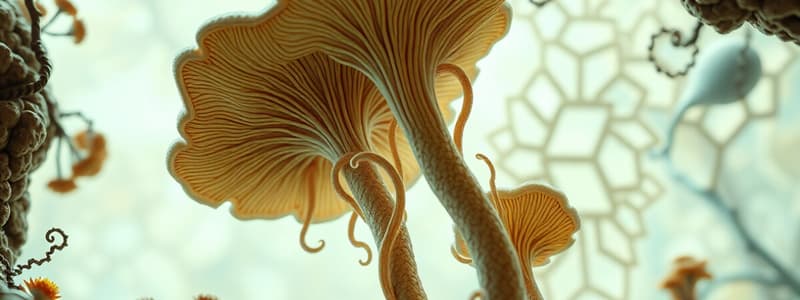Podcast
Questions and Answers
Which characteristic is common to all fungi?
Which characteristic is common to all fungi?
- They are all heterotrophic. (correct)
- They all reproduce sexually.
- They are all unicellular.
- They all contain chitin in their cell walls.
What is the primary function of rhizoids in the structure of a fungus like Rhizopus?
What is the primary function of rhizoids in the structure of a fungus like Rhizopus?
- To produce spores for reproduction.
- To grow vertically and develop sporangia.
- To anchor the mycelium. (correct)
- To branch horizontally on the substrate surface.
What is the name given to the interwoven mass of hyphae that constitutes the vegetative body of a fungus?
What is the name given to the interwoven mass of hyphae that constitutes the vegetative body of a fungus?
- Sporangiophore
- Stolon
- Mycelium (correct)
- Coenocyte
A fungus like Rhizopus, which lacks true roots, stems, and leaves, is described as:
A fungus like Rhizopus, which lacks true roots, stems, and leaves, is described as:
What is the primary role of sporangiophores in fungal structure?
What is the primary role of sporangiophores in fungal structure?
Which of the following describes the nature of a saprotrophic fungus?
Which of the following describes the nature of a saprotrophic fungus?
What does the term 'coenocyte' mean in the context of fungal hyphae?
What does the term 'coenocyte' mean in the context of fungal hyphae?
How do fungi store carbohydrates?
How do fungi store carbohydrates?
Flashcards
Fungi
Fungi
Organisms like moulds, yeasts, and mushrooms in the kingdom Fungi.
Macroscopic fungi
Macroscopic fungi
Large fungi visible to the naked eye, such as mushrooms.
Hyphae
Hyphae
Branched filaments that make up multicellular fungi.
Mycelium
Mycelium
Signup and view all the flashcards
Sporangiophores
Sporangiophores
Signup and view all the flashcards
Saprotrophic fungi
Saprotrophic fungi
Signup and view all the flashcards
Parasitic fungi
Parasitic fungi
Signup and view all the flashcards
Eukaryotic fungi
Eukaryotic fungi
Signup and view all the flashcards
Study Notes
Basic Structure and Function of Fungi
- Fungi include various organisms like molds, yeasts, mildews, rusts, toadstools, and mushrooms.
- They are categorized as macroscopic (e.g., mushrooms) or microscopic (e.g., bread molds).
- Fungi are eukaryotes, possessing a true nucleus.
- Most fungi are saprophytes, feeding on dead organic matter. Some are parasitic, living on living organisms.
Structure of Fungi
- Fungi, like Rhizopus, are typically multicellular, composed of branched filaments called hyphae.
- Hyphae lack cross-walls and contain cytoplasm and multiple nuclei. A single hypha is a coenocyte.
- Hyphae are categorized as:
- Runners (stolons): branch horizontally on substrates.
- Rhizoids: penetrate the substrate, anchoring the mycelium.
- Sporangiophores: grow vertically, forming sporangia that produce spores.
- The interwoven network of hyphae is called a mycelium.
- Spores are reproductive structures found at the tips of hyphae.
- Fungi lacking true roots, stems, or leaves are called thallus.
- Fungi cell walls can contain chitin or cellulose. Chitin is harder and contains nitrogen.
Function and Characteristics of Fungi
- Some fungi are unicellular (e.g., yeasts, molds), others multicellular (e.g., mushrooms).
- Fungi lack chlorophyll and are heterotrophic, meaning they don't photosynthesize.
- Fungi can be saprotrophic (feeding on dead matter) or parasitic (feeding on living organisms).
- To digest matter, saprotrophic fungi secrete enzymes, absorbing the resulting nutrients.
- Fungi can cause diseases such as thrush, ringworm, and athlete's foot.
- Fungi store carbohydrates as glycogen.
- Fungi are crucial for nutrient recycling in soil and atmosphere.
- Fungi reproduce both sexually and asexually.
- Unicellular fungi reproduce asexually by binary fission or budding.
- Multicellular fungi reproduce asexually by spores when conditions are unfavorable, and sexually under favorable conditions.
Studying That Suits You
Use AI to generate personalized quizzes and flashcards to suit your learning preferences.




